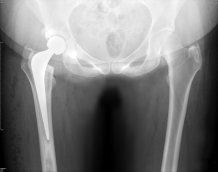Articles

The millionth implant was made in 2010, with almost a further million used since
Exeter Recognised in UK’s Top Breakthroughs List for Revolutionary Hip Replacement
The Exeter Hip has been listed as one of the UK’s 100 best breakthroughs for its life-changing impact on nearly two million lives across half a century.
Universities UK, the umbrella group for all UK Universities, has recognised the Exeter Hip prosthetic implant, which is known as industry gold standard. It is currently used in 125,000 hip replacements each year, a number that continues to increase yearly. To date, it has improved mobility for nearly 2 million people.
The Exeter hip was designed in 1969 as a collaboration between NHS surgeon Professor Robin Ling and Dr Clive Lee, an engineer at the University of Exeter. The first hip was implanted in autumn the following year at the Princess Elizabeth Orthopaedic Hospital (PEOH).
A hip prosthesis is fixed to bone using a polymer - acrylic bone cement. Previous prosthetic hips had been designed with the idea that the implant should remain rigidly fixed to the acrylic.
Ling and Lee’s design was revolutionary – a tapered stem made with a polished surface which allowed the implant to subside slightly into the acrylic, self-tightening as it did so. This made best use of the material properties of the polymer when bearing weight as the person moved on their new hip.
It is said that both Ling and Lee acknowledged that “serendipity” was a large factor in the creation of the design, but the result was remarkable long-term fixation. This became the bedrock of the Exeter hip’s success.
Professor John Timperley, one of the surgeons at the Hip Unit in Exeter, who was awarded an Honorary Chair in the College of Engineering, Mathematics and Physical Sciences at the University of Exeter, notes: “The science behind the Exeter stem and how it works is part of the core teaching for all orthopaedic surgeons around the world.
“The contribution of these two men to hip replacement surgery cannot be overestimated. The partnership between the University and Exeter Hip Unit continues and recently a post-graduate Robin Ling Lecturer has been appointed to drive further collaborative research between our teams.”
The Exeter Hip has become the most successful cemented hip replacement, used across nearly every continent. The millionth implant was made in 2010, with almost a further million used since.
Professor Janice Kay, of the University of Exeter, said: “We’re very proud of Exeter’s role in this revolutionary invention that has improved millions of lives around the world. It’s a fantastic example of the global impact of collaboration between the University and our outstanding NHS partners.”
The original design concept, now manufactured by Stryker, has changed very little over the years, although five decades of research have led to several improved revisions.
Robin Ling had joined the PEOH in 1963 as a consultant orthopaedic surgeon. His collaboration with Clive Lee began when he approached the engineer with a proposition: to design a hip stem suitable for Exeter surgeons’ unique posterior approach to the surgery. The two continued to work together for 50 years as they sought to refine their design.
With typical foresight, Robin established the Hip Research Unit at Exeter in the 1980s, creating a unique database of long-term follow up that is renowned worldwide.
When Robin Ling died last October, his name was given to a ward at the Royal Devon and Exeter Hospital in recognition of the huge contribution that he had made to his profession, the city of Exeter and to patients around the world.
The Universities UK list of breakthroughs demonstrates the significant day-to-day impact of the research conducted at UK universities. These discoveries, innovations and social initiatives include the discovery of penicillin, tackling plastic pollution, ultrasound scans, and the introduction of the Living Wage.
The Exeter Hip has been selected to represent just one of the University of Exeter’s contributions to public life.
Professor Dame Janet Beer, President of Universities UK, said: “Universities really do transform lives. The technology we use every day, the medicines that save lives, the teachers who inspire – all come from UK universities and the important work being done by academics.
“The UK’s Best Breakthroughs list is a testament to the difference that universities make to people’s lives and we want everyone to join us in celebrating the work they do.”
You can find out more about the UK’s Best Breakthroughs and the MadeAtUni campaign here.
Date: 6 December 2018

